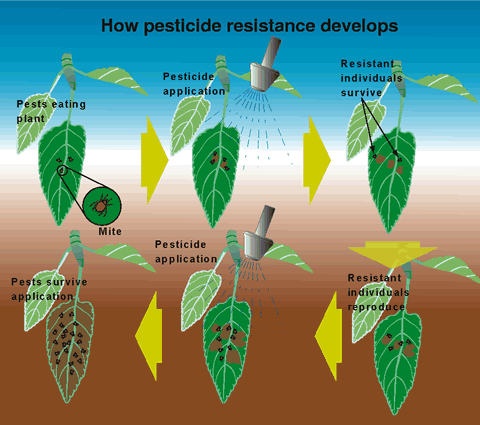How Pesticide Resistance Develops
Excerpt from Fruit Crop Ecology and Management, Chapter 2: Managing the Community of Pests and Beneficials by Larry Gut, Annemiek Schilder, Rufus Isaacs and Patricia McManus
The role of population genetics
An individual organism's genes determine its physical and behavioral traits. When individuals reproduce, they pass along unique combinations of genes to their offspring. Different environments favor individuals with different physical and behavioral traits. Individuals with genes that improve their survival will be more likely to pass along these genes compared to the rest of the population. The mix of genes in a population is called the gene pool. The composition of the gene pool continually changes over time through a process called natural selection.
With the help of plant breeders, fruit growers have taken advantage of the gene pool's natural variability in a process known as artificial selection. The first step in this process is to identify desirable traits, such as flavor, color, tolerance, or resistance to a pest. Once desirable traits are identified, these can be incorporated into new crop varieties through conventional breeding or genetic engineering. For example, apples have been bred to create a few varieties that are resistant to apple scab. Even without specific breeding efforts, fruit crop varieties display a natural range of resistance to various pests and diseases. When monocultures of single varieties are planted, efficiency of production is traded for diversity of resistance to pests.
Effects of pesticide selection
Repeated use of the same class of pesticides to control a pest can cause undesirable changes in the gene pool of a pest leading to another form of artificial selection, pesticide resistance. When a pesticide is first used, a small proportion of the pest population may survive exposure to the material due to their distinct genetic makeup. These individuals pass along the genes for resistance to the next generation. Subsequent uses of the pesticide increase the proportion of less-susceptible individuals in the population. Through this process of selection, the population gradually develops resistance to the pesticide. Worldwide, more than 500 species of insects, mites, and spiders have developed some level of pesticide resistance. The twospotted spider mite is a pest of most fruit crops and is notorious for rapidly developing resistance to miticides.

Some plant pathogens have also become resistant to pesticides. Among fruit producers in North America, apple growers perhaps have faced the most significant problems with pesticide resistance. Examples include streptomycin resistance in the fire blight bacterium and benomyl resistance in the apple scab pathogen. Although the precise genetic and ecological factors differ among pests that have become resistant, in all cases resistance is driven by one process -- selection.
Insecticide resistance
Selection for resistance can occur if a small proportion of the insect population is able to survive treatment with insecticide. These rare resistant individuals can reproduce and pass on their resistance to the offspring. If an insecticide with the same mode of action is repeatedly used against this population, an even greater proportion will survive. Ultimately, the once-effective product no longer controls the resistant population.
Fungicide resistance
Single-step pesticide resistance arises suddenly in the field. A single gene or physiological function changes so that an individual becomes highly resistant to the pesticide. With just one or two sprays of the pesticide, the population shifts from mostly sensitive to mostly resistant individuals. This is the process by which populations of streptomycin-resistant fire blight bacteria and benomyl-resistant apple scab bacteria rapidly developed in commercial orchards.
Multi-step pesticide resistance arises slowly in the field over many years. Rather than having distinct groups of sensitive and resistant individuals, the population consists of individuals with a range of sensitivities to the pesticide. With each pesticide application, those individuals at the more resistant end of the spectrum survive and reproduce. Over the years, the proportion of the population that can survive a pesticide spray increases, until that pesticide eventually becomes ineffective. This process is underway in apple orchards where the sterol inhibitor (SI) fungicides have been used extensively to control scab. The shift toward resistance leads to a gradual erosion of control.
Resistance management
Growers can help delay the development of resistance by applying pesticides only when they are needed, by rotating between different chemical classes, and by using rates of pesticides within the labeled range. Integrating non-chemical approaches such as pheromone mating disruption and cultural controls can also help delay resistance.



 Print
Print Email
Email